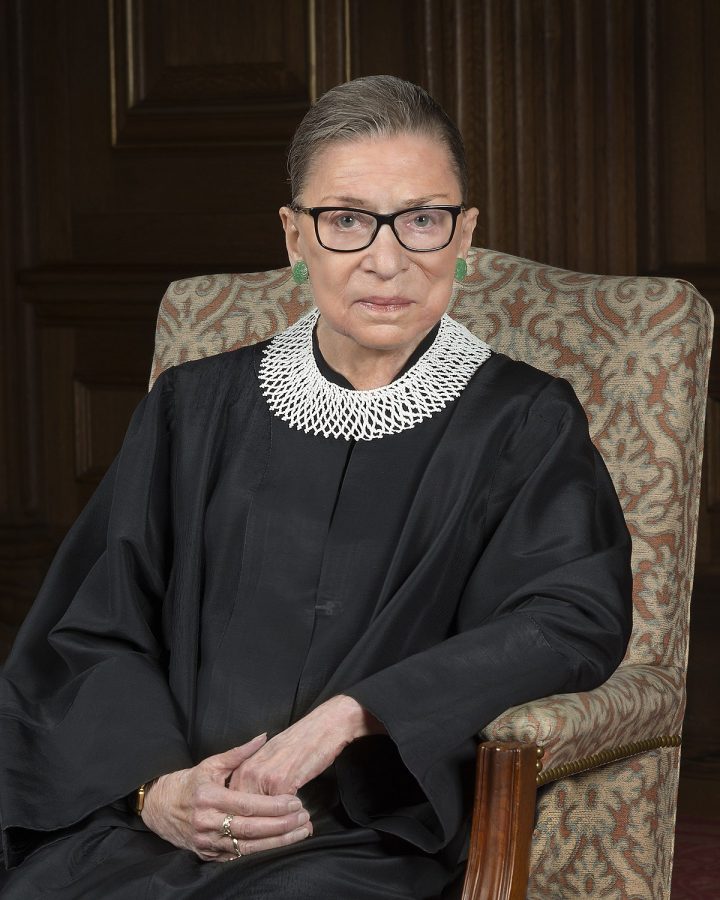Remembering Ruth Bader Ginsburg
September 23, 2020
On Friday, September 18, our nation lost a powerful figure of justice and equality. Justice Ruth Bader Ginsburg passed away due to complications from metastatic pancreas cancer, the Supreme Court announced in a press release. Justice Ginsburg was 87.
Her death not only leaves a vacancy on the Supreme Court, but in the fight for equality. She was an avid leader in the movement for women’s rights, being the second woman on the Supreme Court. Before she was appointed to the Supreme Court by President Clinton in 1993, she was a strong advocate against gender discrimination, arguing many cases for both women and men who were discriminated against.
Ginsburg was born on March 15, 1933 as Joan Ruth Bader in Brooklyn, New York, where as a toddler she earned the nickname “Kiki” because she was always kicking.
Ginsburg’s passion for justice and equality was fostered early on, helped along by her mother, who was very invested in her children’s education. As Ginsburg said, “My mother told me to be a lady. And for her, that meant be your own person, be independent.”
Despite the tragic death of her mother, Ginsburg took the advice to heart and excelled in college, graduating at the top of her class at Cornell University in 1954 with a bachelors in government. That same year she married Martin Ginsburg, whom she met in ‘53. In 1955, a year before she enrolled in Harvard Law School, her daughter Jane Ginsburg was born.
When she started at Harvard Law School in ‘56, she was one of only nine women in the class of about 500. There, despite scorn from the Dean of Students who asked the women why they were taking a place that could have gone to a man, she rose to the top and graduated in 1959.
However, even though she had an outstanding education and work ethic, she was repeatedly denied jobs and positions due to her gender. Ginsburg said that in addition to being a Jewish woman she was also a mother, which was another strike.
This discrimination only made her more determined. She eventually landed a clerkship for Judge Edmund Palmieri, and in 1963 got a job teaching at Rutgers Law School where she still faced adversity. She hid her pregnancy until her contract was renewed so that she wouldn’t be penalized. Still, she pressed on to fight the inequality.
“Fight for the things that you care about, but do it in a way that will lead others to join you.”
– Ruth Bader Ginsburg
In 1970, she defended Moritz in the case of Moritz v. Commissioner of International Revenue. Charles E. Moritz, a bachelor taking care of his mother, had been denied a tax deduction normally given to people who had to take care of dependents simply because he was a man who never married. This was the case that helped fuel her pursuit of gender equality. Moritz v. Commissioner was also the case that was featured in “On the Basis of Sex,” a film about RBG. As shown in the film, the American Civil Liberties Union (ACLU) helped back Ginsburg as they argued that the statute should be extended to cover both men and women who had to care for dependents. The government’s response was to dredge up every law that had a difference between men and women to show what Ginsburg was getting into. The court decided that the current ruling was unconstitutional; denying Mr. Moritz a tax deduction because he was a man violated the 14th amendment.
In 1972, she founded the Women’s Rights Project at the ACLU. The Women’s Rights Project worked to battle gender discrimination, and with RBG at the head, they scored numerous victories. Ginsburg herself argued six cases in front of the Supreme Court, winning five of them.
In addition to fighting for women’s equality, she argued for men’s equality too. Much like Moritz v. Commissioner, she argued against statutes that didn’t apply to men, due to society’s gender role stereotypes. Presenting in front of often all male courts made her realize that she had to show gender discrimination in a way that they could understand. If she showed it was negatively affecting men, the male judges were more likely to rule against the discrimination. The executive director of the ACLU at the time, Aryeh Neier, said of her, “Ruth was careful to build brick upon brick.” This methodical strategy of fighting discrimination on the basis of sex made her a formidable lawyer, and she rose to prominence, eventually becoming a Supreme Court justice, appointed by President Clinton in 1993. She was confirmed by a Senate vote of 96 to 3, with one refraining from voting.
As a Supreme Court Justice, she continued to advocate for equality. The famous “I dissent” line became part of her persona. When she didn’t agree with the majority opinion, she wrote strong dissenting opinions. She was known for her tough questioning and firm beliefs. The late Justice Scalia said she was “a tigress on civil procedure.” Interestingly, although Scalia and Ginsburg were often on opposite sides of political divides, they were “best buddies,” in the words of Justice Ginsburg. Another fun fact is that her numerous iconic collars, or jabots, each have a different meaning and are meant for a different occasion. She has a gold one for when she’s with the majority opinion, and of course her famous dissent collar, which she also wore after Trump’s election. (In the words of SNL’s Kate McKinnon acting as RBG, “That’s a Ginsburn!”)
RBG was certainly a force to be reckoned with. She worked out with a personal trainer, doing 20 push-ups at a time in her 70’s and 80’s. And in 2013, after her famous dissent from the Shelby County v. Holder case, the nickname “Notorious RBG” came into existence, a name inspired by the rapper Notorious B.I.G., Biggie Smalls. The franchise soon followed, and “Notorious RBG” became a pop culture icon. T-shirts depicting her wearing her iconic lace collars, along with some of her quotes, became popular. She became a role model for people of all ages. Her dedication and pursuit of gender equality brought about changes that have helped countless people.
Her death added more heat to the upcoming election and is surrounded by attempts to fill her place. Some believe that she should have retired when Obama was president so he could have filled her spot with another liberal. In the last six months of Obama’s presidency, a Republican led Senate denied Obama’s nomination to fill Justice Antonin Scalia’s spot, because as Senate leader Mitch McConnell said, “The American people should have a voice in the selection of their next Supreme Court Justice,” and waiting for the election would provide that opportunity. However, Republicans are now pushing to secure a nomination. “My most fervent wish is that I will not be replaced until a new president is installed,” Ginsburg told her granddaughter Clara Spera, a few days before her death.
Outside the political battle, vigils and memorials were set up outside the Supreme Court, and social media blew up with photos commemorating her life and legacy. Her strength allowed her to fight discrimination on the basis of sex, while overcoming it it herself. Her relentless work ethic helped win landmark cases and get her appointed to the SCOTUS, and her strong willed opinions brought her to prominence among Americans young and old. She was a symbol of following your passion and fighting for what you believe in. Justice Ruth Bader Ginsburg, The Notorious RBG, the Robed Crusader made an impact on this world, paving the way for others to do so as well.















